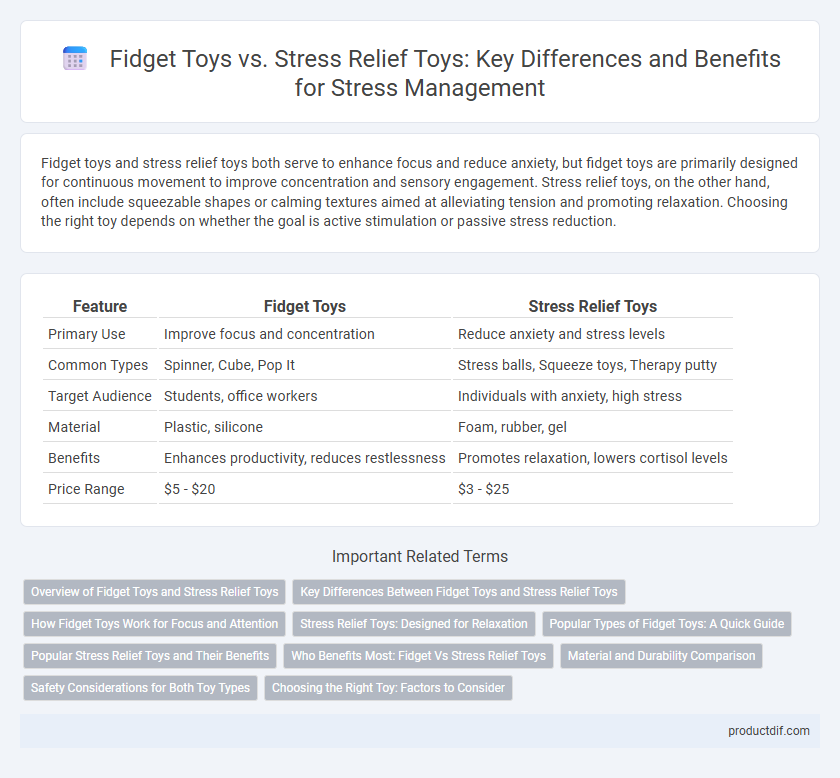Fidget toys and stress relief toys both serve to enhance focus and reduce anxiety, but fidget toys are primarily designed for continuous movement to improve concentration and sensory engagement. Stress relief toys, on the other hand, often include squeezable shapes or calming textures aimed at alleviating tension and promoting relaxation. Choosing the right toy depends on whether the goal is active stimulation or passive stress reduction.
Table of Comparison
| Feature | Fidget Toys | Stress Relief Toys |
|---|---|---|
| Primary Use | Improve focus and concentration | Reduce anxiety and stress levels |
| Common Types | Spinner, Cube, Pop It | Stress balls, Squeeze toys, Therapy putty |
| Target Audience | Students, office workers | Individuals with anxiety, high stress |
| Material | Plastic, silicone | Foam, rubber, gel |
| Benefits | Enhances productivity, reduces restlessness | Promotes relaxation, lowers cortisol levels |
| Price Range | $5 - $20 | $3 - $25 |
Overview of Fidget Toys and Stress Relief Toys
Fidget toys, such as spinners, cubes, and putty, are designed to provide sensory stimulation and improve focus through repetitive hand movements. Stress relief toys, including stress balls, squeeze toys, and aromatherapy gadgets, aim to reduce anxiety and promote relaxation by engaging different senses and encouraging calming actions. Both types of toys cater to mental well-being but target distinct needs: fidget toys enhance concentration, while stress relief toys alleviate tension.
Key Differences Between Fidget Toys and Stress Relief Toys
Fidget toys are designed primarily to improve focus and concentration through repetitive hand movements, while stress relief toys aim to reduce anxiety and promote relaxation by providing calming sensory input. The materials and mechanisms differ: fidget toys often include spinners, cubes, or stretchy bands for tactile stimulation, whereas stress relief toys may incorporate soft textures, squeezable components, or aromatic elements to soothe nerves. Usage context also varies; fidget toys are commonly used during tasks requiring attention, whereas stress relief toys are utilized in moments of emotional distress or tension.
How Fidget Toys Work for Focus and Attention
Fidget toys engage the hands in repetitive, simple motions that help maintain focus and improve attention by providing sensory input and reducing restlessness. The tactile stimulation from fidget toys activates neural pathways that enhance cognitive function and promote sustained concentration, especially for individuals with ADHD or anxiety. By channeling excess energy into a controlled activity, fidget toys help minimize distractions, making them effective tools for improving productivity and mental clarity.
Stress Relief Toys: Designed for Relaxation
Stress relief toys, designed for relaxation, help reduce anxiety and promote calmness through tactile engagement and soothing repetitive motions. Popular examples include stress balls, handheld massagers, and aromatherapy-infused objects, each scientifically proven to lower cortisol levels and improve mood. These toys complement therapeutic practices by providing portable, instant access to stress management tools ideal for all ages.
Popular Types of Fidget Toys: A Quick Guide
Popular types of fidget toys include spinners, cubes, and stress balls, each designed to improve focus and reduce anxiety through tactile engagement. Spinners offer smooth, repetitive spinning motions, while fidget cubes provide multiple sensory features like buttons, switches, and dials for varied stimulation. Stress balls promote hand muscle relaxation and improve dexterity, making them ideal stress relief toys for both children and adults.
Popular Stress Relief Toys and Their Benefits
Popular stress relief toys like fidget spinners, stress balls, and squishy toys offer effective ways to reduce anxiety and enhance focus. These toys stimulate sensory engagement, helping to calm the nervous system while promoting mindfulness. Their portability and ease of use make them ideal tools for managing stress in various settings, from work to school.
Who Benefits Most: Fidget Vs Stress Relief Toys
Fidget toys primarily benefit individuals with attention deficits, anxiety, and sensory processing challenges by providing tactile stimulation that enhances focus and reduces restlessness. Stress relief toys, such as stress balls and calming kits, are more effective for users seeking to alleviate tension and promote relaxation after stressful events. Both types of toys serve distinct purposes, with fidget toys targeting cognitive engagement and stress relief toys addressing emotional decompression.
Material and Durability Comparison
Fidget toys are commonly made from plastic or silicone, offering lightweight durability suitable for frequent handling and portable use. Stress relief toys often utilize stress-absorbing materials like memory foam or rubber, which provide a softer texture ideal for squeezing and pressure release but may wear out faster than harder plastics. The choice between materials directly impacts the longevity and tactile experience, with plastic-based fidget toys generally lasting longer under repetitive use compared to foam-based stress relief toys.
Safety Considerations for Both Toy Types
Fidget toys and stress relief toys both require rigorous safety standards to prevent choking hazards, particularly for children under three years old. Materials used in these toys should be non-toxic, BPA-free, and free from harmful chemicals like phthalates, ensuring long-term health safety. Durability is crucial to avoid breakage into small parts, with ASTM F963-17 compliance serving as a benchmark for quality and safety in the toy industry.
Choosing the Right Toy: Factors to Consider
When choosing between fidget toys and stress relief toys, consider the primary purpose: fidget toys enhance focus and sensory stimulation, while stress relief toys aim to reduce anxiety and calm the mind. Material quality, durability, and ease of use are critical factors to ensure prolonged engagement and effectiveness. User preference, including size, texture, and portability, also plays a significant role in selecting the right toy for individual needs.
Fidget toys vs stress relief toys Infographic

 productdif.com
productdif.com